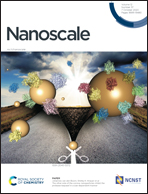Design guidelines for transition metals as interstitial emitters in silicon nanocrystals to tune photoluminescence properties: zinc as biocompatible example†
Abstract
Silicon nanocrystals (Si NCs) are attractive candidates for biomarkers in medical imaging. Building on recent work [McVey et al., J. Chem. Phys. Lett., 2015, 6/9, 1573; McVey et al., Nanoscale, 2018, 15600], we focus on interstitial (i-) doping of Si NCs by transition metals (TMs), and investigate the optoelectronic structure with Zn as example. Carrying out extensive ground and excited state calculations using density functional theory (DFT), we provide insight into the interdependencies of parameters which define photoluminescence (PL) properties as per TM element, their position, and their density within Si NCs of realistic size. For i-Zn in Si NCs, we predict a very high radiation efficiency with a wavelength located well above the range of auto-luminescence originating from human tissue and blood. We derive general guidelines for i-TM doping of Si NCs to arrive at a desired emission wavelength with maximum radiation efficiency. Moving on from this general description, we reveal the concept of using the plasmonic resonance of i-TM dopants in the microwave (μW) spectrum to trigger selective thermal apoptosis of tagged cells in vivo after cell marking, paving the way towards a theragnostics tool with minimum side effects.



 Please wait while we load your content...
Please wait while we load your content...